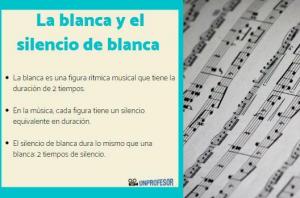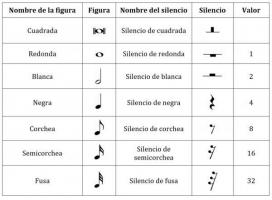List with the different TYPES of CHORDS
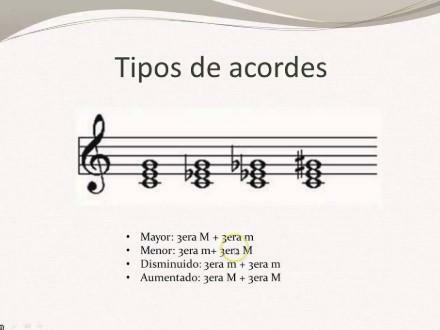
Image: Slideshare
Sound is a physical phenomenon like any other natural phenomenon. Fortunately for us, humanity has managed to evolve this phenomenon into an art, music. There are many elements in music that makes it a complex and wonderful art. It is the combination of these elements in their infinite ways of relating to each other that makes it so interesting. In this article by a TEACHER we will learn about different types of chords that exist since the chord is one of the most important elements of music in its structure.
To talk about a chord it is important that we understand the concept of "harmony". Harmony is the relationship that have two or more sounds with each other. This musical element is so important that we could call it the "skeleton" of a song or work, because it is in charge of defining its structure.
Each step of this structure or each “brick” (if we compare it to a construction) is a chord. The chord is, for practical purposes, is when two or more notes sound simultaneously
. It is the relationship between them that defines a chord and this can be as simple as it is complex. Naturally, the more notes a chord has, the more relationships are created between the notes and the sounds, and therefore it is more complex to analyze it.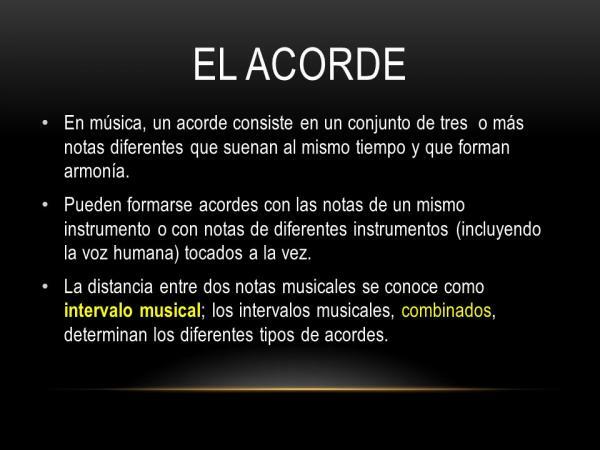
Image: Slideplayer
To analyze these relationships between notes we use a concept: "interval". The interval is the distance between one note and another. Depending on the interval, we call the relationship of these notes differently, that is, that depending on the intervals between the notes, the chord will have a classification different. The musical unit for measuring an interval is the "tone".
In Western music the conventional is to use the "tone" and the "semitone". On the piano it is very easy to visualize the distances between the notes, there is a complete tone between one note and another when there is a key in between. For example, we can see that between Do and Re there is a black key, so its distance is 1 tone full. But if we look at the keys for my and fa, we will see that there are no keys in between, so their distance is 1 semitone.
As they exist 7 musical notes (Do, Re, Mi, Fa, Sol, La, Si), the intervals also go from 1 to 7. We call the first note of a chord the "root" note because it is the one that gives the chord its name (If the root is an F, the chord will be some F chord). The rest of the notes are named after cardinal numbers (second, third, fourth, etc). For example, if our root note is C, that's what we would call the rest of the interval notes:
- Do - Fundamental
- Re - Second
- My - Third
- Fa - Fourth
- Sun - Fifth
- The sixth
- Yes - Seventh
- C - Octave
A chord can be made up of intervals that are even beyond the seventh. The next note after the seventh, when the fundamental repeats, we call it "eighth".
Extra knowledge: Although the notes are repeated, if the octave is different, the intervals are named after the octave. In other words, if C was our fundamental, and we already reached C in the octave, the next D would not be a second but a ninth. Without going into much detail, we call these intervals that exceed the eighth "Tensions" and only the ninth, eleven and thirteen are used.

Image: Youtube
Although the variety of chords is wide, we can divide the chord types into 2 large groups: Triads and Quadriads. Triads, as the name implies, is a 3-note chord. The quadriad is a four note chord. Since quadriads are more complex, we'll save that topic for another time and focus on Triads:
What is the triad in music
A triad is made up of the following notes: Fundamental, third and fifth. Depending on the position of the third and fifth, the chord will have a different name.
The fundamental, as we have mentioned before, gives the name to the chord. Now the third, It is very important because it will tell us what type of triad the chord is.
- If the third of the chord is 2 tones from the root, this will be amajor chord
- If the third of the chord is 1 1/2 pitch from the root, this will be a minor chord
Refering to fifth, in most cases the fifth in a chord is 3 ½ tones from the fundamental. We call this type of fifth "Fair fifth" But when the fifth shifts half a tone down or up, we already have a different chord.
- If the fifth of a major chord increases ½ tone (total of 4 tones from the fundamental) we call it augmented chord.
- If the fifth of a minor chord decreases ½ tone (total of 3 tones from the fundamental) we call it diminished chord.
Suspended chords
Suspended chords have second and fourth intervals, which replace the third. Because they do not have the third, these are harmonically ambiguous chords.
- Suspended second chord: It is made up of the fundamental, the second(1 tone from the fundamental) and the fifth.
- Fourth: It is made up of the fundamental, the quarter (at 2 1/2 tones of the fundamental) and the fifth.
What is the cuatriada in music
A quadriad is made up of 4 notes. They can be consistent with sixth or chords with seventh. They are made up of the following way Fundamental, third, fifth and (sixth or seventh). Depending on the position of the third, fifth, sixth, or seventh, the chord will have a different name. In this article we will use the letter "F" to refer to the fundamental, the letter "M" to refer to a larger interval, and "M" (lowercase) to refer to a smaller interval. Finally we will use the sign + for an augmented note and dis for a diminished note.
Sixth chords
- Major sixth chord: F 3M 5 6M
- Minor sixth chord: F 3m 5 6m
Seventh chords
As in the third, the seventh can also be greater (to ½ octave descendant) or less (1 tone descending from the octave).
- Higher: F 3M 5 7M
- Less: F 3m 5 7m
- Dominant: F 3M 5 7m
- Augmented seventh chord: F 3M 5+ 7m
- Diminished: F 3m 5dis 7dis
- Semi-diminished: F 3m 5 7m
- Minor major seventh chord: F 3m 5 7M
It is thanks to the different chords that we have such a variety of works. Harmony is the structure of music and as such, it has the power to determine the whole meaning of a song or work. Chords can make something sound very funny, or perhaps sad and melancholic. It's wonderful that we do this simply by changing a couple of notes.
Now that you know about chord types, you will be able to understand and enjoy music more. If you liked reading this unPROFESSOR article, we invite you to leave a comment.
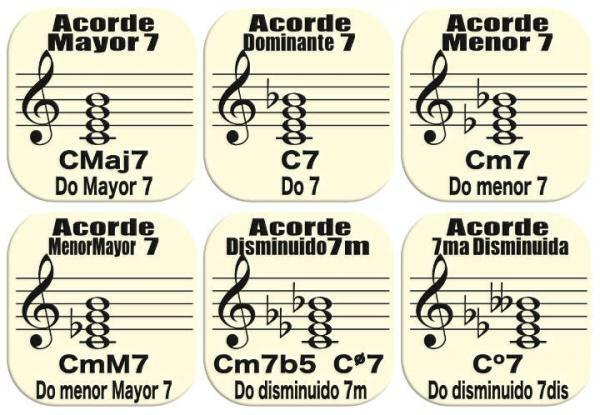
Image: Lapnayh

